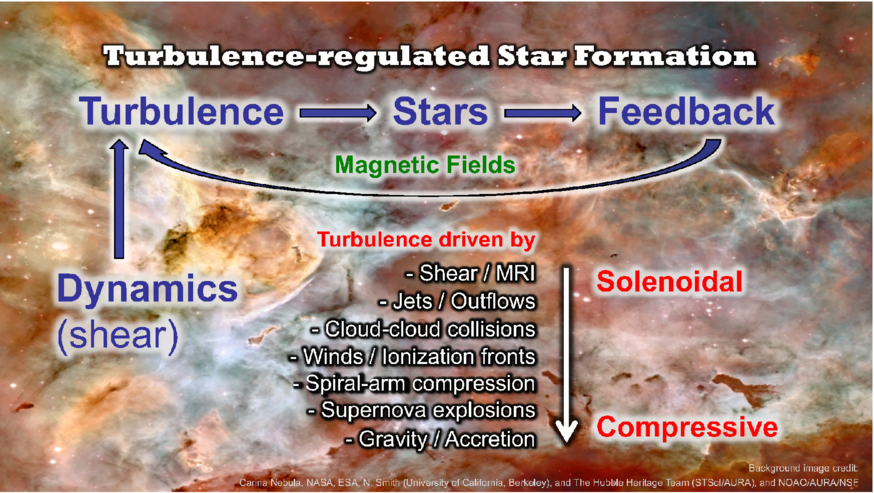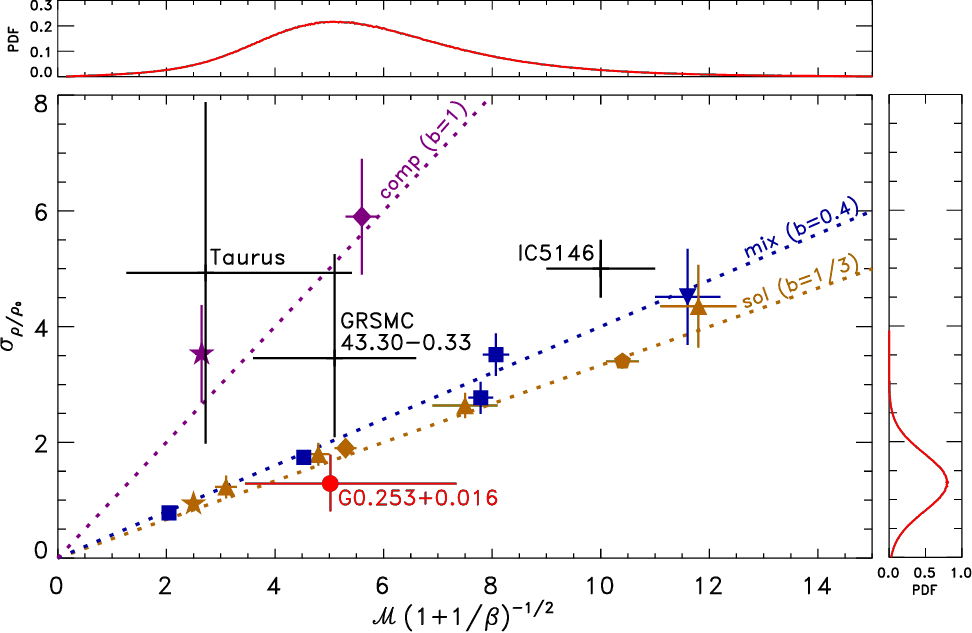
Contact Info
Australian National University
christoph.federrath@anu.edu.au
+61 (0)2 6125 0217
0000-0002-0706-2306
GitHub Bitbucket
Star formation is primarily controlled by the interplay between gravity, turbulence, and magnetic fields. However, the turbulence and magnetic fields in molecular clouds near the Galactic Center may differ substantially from spiral-arm clouds. Here we determine the physical parameters of the central molecular zone (CMZ) cloud G0.253+0.016, its turbulence, magnetic field and filamentary structure. Using column-density maps based on dust-continuum emission observations with ALMA+Herschel, we identify filaments and show that at least one dense core is located along them. We measure the filament width W_fil=0.17+/-0.08pc and the sonic scale lambda_sonic=0.15+/-0.11pc of the turbulence, and find W_fil~lambda_sonic. A strong velocity gradient is seen in the HNCO intensity-weighted velocity maps obtained with ALMA+Mopra, which is likely caused by large-scale shearing of G0.253+0.016, producing a wide double-peaked velocity PDF. After subtracting the gradient to isolate the turbulent motions, we find a nearly Gaussian velocity PDF typical for turbulence. We measure the total and turbulent velocity dispersion, 8.8+/-0.2km/s and 3.9+/-0.1km/s, respectively. Using magnetohydrodynamical simulations, we find that G0.253+0.016's turbulent magnetic field B_turb=130+/-50muG is only ~1/10 of the ordered field component. Combining these measurements, we reconstruct the dominant turbulence driving mode in G0.253+0.016 and find a driving parameter b=0.22+/-0.12, indicating solenoidal (divergence-free) driving. We compare this to spiral-arm clouds, which typically have a significant compressive (curl-free) driving component (b>0.4). Motivated by previous reports of strong shearing motions in the CMZ, we speculate that shear causes the solenoidal driving in G0.253+0.016 and show that this reduces the star formation rate (SFR) by a factor of 6.9 compared to typical nearby clouds.

The Figure shows a sketch of the turbulence-regulated paradigm of star formation. Turbulence is fed by stellar feedback and/or large-scale dynamics (such as galactic shear). Different turbulence driving mechanisms can excite more solenoidal (rotational) modes, others inject more compressive (potential) modes. The mix of turbulent modes has profound consequences for star formation.

This Figure shows the relation between the turbulent density fluctuations and the combination of sonic Mach number and plasma beta. This relation defines the turbulence driving parameter b. The three dotted lines show three representative driving cases: purely solenoidal driving (b = 1/3, gold), naturally-mixed driving (b = 0.4, blue), and purely compressive driving (b = 1, purple). Numerical simulations are shown as symbols (with the color indicating the applied driving mode: sol, mix or comp): from Federrath et al. (2008b, 2010) (diamonds), Price et al. (2011) (pentagon), Molina et al. (2012) (squares), Konstandin et al. (2012) (stars), Nolan et al. (2015) (triangles), and Federrath & Banerjee (2015) (upside-down triangle). The black crosses are measurements in the Milky Way spiral-arm clouds Taurus (Brunt 2010), GRSMC43.30-0.33 (Ginsburg et al. 2013), and IC5146 (Padoan et al. 1997a). Our measurement for G0.253+0.016 is shown as the red circle with 1-sigma uncertainties drawn from the PDFs in the top and right panels. This indicates solenoidal driving of the turbulence in G0.253+0.016, i.e., b < 0.4. By contrast, all three spiral-arm clouds show a significant compressive driving component, b > 0.4.
We thank A. Ginsburg for discussions on the thermal structure and T. Pillai and J. Kauffmann for discussions on the ordered magnetic field in G0.253+0.016. We further thank T. Csengeri, R. Klessen, V. Ossenkopf and N. Schneider for discussions on noise, foreground corrections and uncertainties in column-density PDFs constructed from interferometric data. We thank the anonymous referees for their prompt and constructive reports. C.F. acknowledges funding provided by the Australian Research Council's Discovery Pro jects (grant DP150104329). C.F. further acknowledges supercomputing time provided by the Jülich Supercomputing Centre (grant hhd20), the Leibniz Rechenzentrum and the Gauss Centre for Supercomputing (grants pr32lo, pr48pi and GCS Large-scale project 10391), the Partnership for Advanced Computing in Europe (PRACE grant pr89mu), the Australian National Computational Infrastructure (grant ek9), and the Pawsey Supercomputing Centre with funding from the Australian Government and the Government of Western Australia. J.M.D.K. gratefully acknowledges financial support in the form of a Gliese Fellowship and an Emmy Noether Research Group from the Deutsche Forschungsgemeinschaft (DFG), grant number KR4801/1-1. R.M.C. is the recipient of an Australian Research Council Future Fellowship (FT110100108). GG acknowledges support from CONICYT Project PFB-06. This work makes use of the following ALMA data: ADS/JAO.ALMA#2011.0.00217.S. ALMA is a partnership of ESO (representing its member states), NSF (USA), and NINS (Japan), together with NRC (Canada) and NSC and ASIAA (Taiwan), in cooperation with the Republic of Chile. The Joint ALMA Observatory is operated by ESO, AUI/NRAO, and NAOJ. The simulation software FLASH used in this work was in part developed by the DOE-supported Flash Center for Computational Science at the University of Chicago. Facilities: ALMA, Herschel, Mopra.